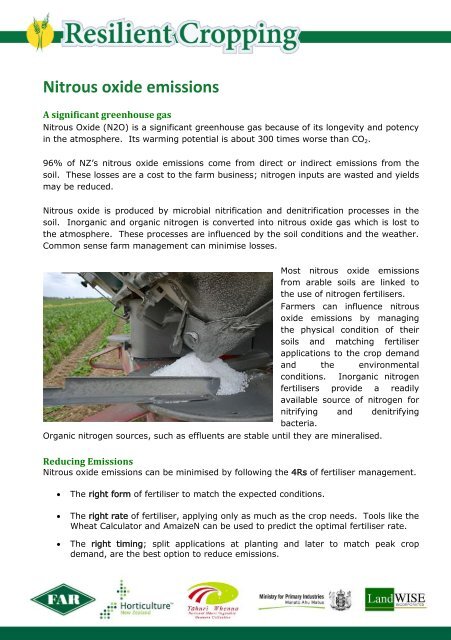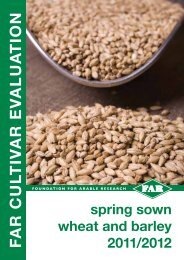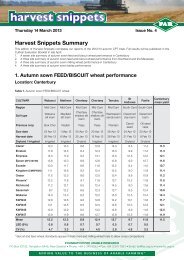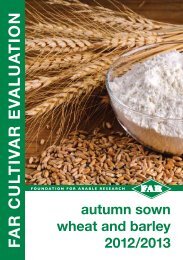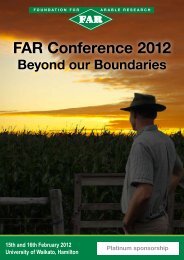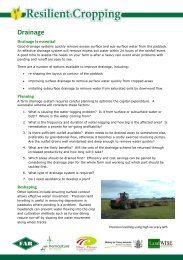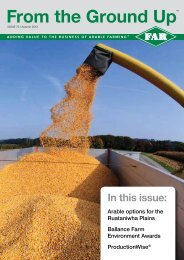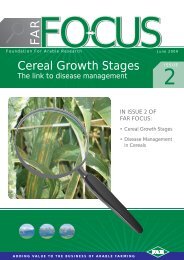Nitrous oxide emissions - FAR
Nitrous oxide emissions - FAR
Nitrous oxide emissions - FAR
Create successful ePaper yourself
Turn your PDF publications into a flip-book with our unique Google optimized e-Paper software.
<strong>Nitrous</strong> <strong>oxide</strong> <strong>emissions</strong><br />
A significant greenhouse gas<br />
<strong>Nitrous</strong> Oxide (N2O) is a significant greenhouse gas because of its longevity and potency<br />
in the atmosphere. Its warming potential is about 300 times worse than CO 2 .<br />
96% of NZ’s nitrous <strong>oxide</strong> <strong>emissions</strong> come from direct or indirect <strong>emissions</strong> from the<br />
soil. These losses are a cost to the farm business; nitrogen inputs are wasted and yields<br />
may be reduced.<br />
<strong>Nitrous</strong> <strong>oxide</strong> is produced by microbial nitrification and denitrification processes in the<br />
soil. Inorganic and organic nitrogen is converted into nitrous <strong>oxide</strong> gas which is lost to<br />
the atmosphere. These processes are influenced by the soil conditions and the weather.<br />
Common sense farm management can minimise losses.<br />
Most nitrous <strong>oxide</strong> <strong>emissions</strong><br />
from arable soils are linked to<br />
the use of nitrogen fertilisers.<br />
Farmers can influence nitrous<br />
<strong>oxide</strong> <strong>emissions</strong> by managing<br />
the physical condition of their<br />
soils and matching fertiliser<br />
applications to the crop demand<br />
and the environmental<br />
conditions. Inorganic nitrogen<br />
fertilisers provide a readily<br />
available source of nitrogen for<br />
nitrifying and denitrifying<br />
bacteria.<br />
Organic nitrogen sources, such as effluents are stable until they are mineralised.<br />
Reducing Emissions<br />
<strong>Nitrous</strong> <strong>oxide</strong> <strong>emissions</strong> can be minimised by following the 4Rs of fertiliser management.<br />
<br />
<br />
<br />
The right form of fertiliser to match the expected conditions.<br />
The right rate of fertiliser, applying only as much as the crop needs. Tools like the<br />
Wheat Calculator and AmaizeN can be used to predict the optimal fertiliser rate.<br />
The right timing; split applications at planting and later to match peak crop<br />
demand, are the best option to reduce <strong>emissions</strong>.
The right placement, broadcast applications are usually less efficient than knifed<br />
or incorporated applications.<br />
Microbial denitrification processes in anaerobic soil conditions cause large <strong>emissions</strong>.<br />
Land management practices that prevent compaction and improve drainage to prevent<br />
anaerobic soil conditions are beneficial.<br />
The use of no-till<br />
practices may increase<br />
the risk of nitrous <strong>oxide</strong><br />
<strong>emissions</strong> in some soils if<br />
they remain consistently<br />
wet and anaerobic<br />
conditions develop.<br />
However the wider<br />
benefits of reduced tillage<br />
should be considered.<br />
Fallow periods should be<br />
short. If there are no<br />
plants to take up the soil<br />
nitrogen, it is at risk of<br />
being lost as nitrous <strong>oxide</strong><br />
or leached as nitrate.<br />
The biggest effect on nitrous <strong>oxide</strong> <strong>emissions</strong> from irrigation is from saturation of the soil<br />
through over application. Irrigation applications should be scheduled to match the soil<br />
moisture balance to crop the demand. Soil moisture monitoring and irrigation<br />
scheduling software, like Aquatrac, are useful tools for irrigators.<br />
It is important to apply water at a rate that matches the soil’s capacity to absorb it.<br />
Runoff can cause ponding in the paddock which accelerates nitrogen loss through<br />
denitrification.<br />
It is also important to check and calibrate all irrigation equipment regularly to ensure it<br />
is performing to specification. Simple methods like setting out catch buckets under the<br />
irrigator to assess its uniformity can highlight maintenance or design features that need<br />
to be fixed.<br />
Reference:<br />
Arable Update 94 Reducing nitrous <strong>oxide</strong> <strong>emissions</strong> from arable farms<br />
<strong>FAR</strong> HortNZ LandWISE Inc Tahuri Whenua<br />
03 345 5783 04 472 03795 06 650 4531 06 356 7589<br />
www.far.org.nz www.hortnz.co.nz www.landwise.org.nz www.tahuriwhenua.org.nz


